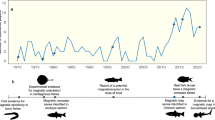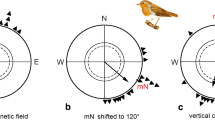Abstract
Elasmobranchs possess a multiplicity of mechanisms controlling posture and short distance orientation. Visual–vestibular contributions to posture and locomotion are well documented. So too, are the contributions of vision, olfaction and the octavolateralis senses to short distance orientation, particularly orientation to specific environmental stimuli such as those generated by prey. Less well understood are the mechanisms guiding orientation over longer distances. Anecdotal and systematic observations of behaviour show tidal, daily, repeat long distance, and even seasonal movement patterns. True navigation has not been demonstrated in elasmobranchs and the sensory mechanisms underlying the above movement patterns remain largely speculative. However, they are likely to include responses to water currents, and physical parameters such as temperature, pressure, and the geomagnetic field. Of particular interest in elasmobranchs is that geomagnetic orientation could be mediated directly via a magnetite based sensory system, or indirectly via the electrosensory system. Systematic studies of movement patterns and experimental studies of the underlying mechanisms of orientation are required to gain an increased understanding of orientation and navigation in this intriguing group.
Similar content being viewed by others
References
Able, K.P. 1996. Large scale navigation. J. Exp. Biol. 199: 1–2.
Barkley, R.A., W.H. Neill & R.M. Gooding. 1978. Skipjacktuna, Katsuwonus pelamis, habitat based on temperature and oxygen requirements. U.S. Fish. Bull. 76: 653–662.
Bone, Q. 1988. Muscles and locomotion. pp. 99–142. In: T.J. Shuttleworth (ed.) Physiology of Elasmobranch Fishes, Springer-Verlag, Berlin.
Carey, F.G. & J.V. Scharold. 1990. Movements of blue sharks (Prionace glauca) in depth and course. Mar. Biol. 106: 329–342.
Castro, J.I. 1993. The shark nursery of Bulls Bay, South Carolina, with a review of the shark nurseries of the southeastern coast of the United States. Env. Biol. Fish. 38: 37–48.
DeJong, H.A.A., E.N.P.M. Sondag, A. Kuipers & W.J. Oosterveld. 1996. Swimming behavior of fish during short periods of weightlessness. Aviation Space & Environmental Medicine 67: 463–466.
Dingle, H. 1996. Migration, the biology of life on the move. Oxford University Press, New York. 474 pp.
Dø ving, K.B., B.H. Westerberg & P.B. Johnsen. 1985. Role of olfaction in the behavioural and neuronal responses of the Atlantic salmon, Salmo salar, to hydrographic stratification. Can. J. Fish. Aquat. Sci. 542: 1658–1667.
Fraenkel, G.S. & D.L. Gunn. 1961. The orientation of animals, kineses, taxes and compass reactions. Dover Publications, New York. 376 pp.
Griffin, D.R. 1952. Bird navigation. Biol. Rev. Camb. Philos. Soc. 27: 359–400.
Groen, J.J., O. Lowenstein & A.J.H. Vendrick. 1952. The mechanical analysis of the responses from the end-organs of the horizontal semicircular canal in the isolated elasmobranch labyrinth. J. Physiol. 117: 54–62.
Gruber, S.H., D.R. Nelson & J.F. Morrissey. 1988. Patterns of activity and space utilization of lemon sharks Negaprion brevirostris in a shallow Bahamian lagoon. Bull. Mar. Sci. 43: 61–76.
Harden Jones, F.R., G.P. Arnold, M. Greer-Walker & P. Scholes. 1979. Selective tidal stream transport and the migration of plaice (Pleuronectes platessa L.) in the southern North Sea. J. Conseil Internat. l'Exploration de la Mer 38: 331–337.
Hartmann, R. & R. Klinke. 1980. Discharge properties of afferent fibres of the goldfish semicircular canal with high frequency stimulation. Pflugers Arch. 388: 111–121.
Hines, A.H., R.B. Whitlatch, S.F. Thrush, J.E. Hewitt, V.J. Cummings, P.K. Dayton & P. Legendre. 1997. Nonlinear foraging response of a large marine predator to benthic prey: eagle ray pits and bivalves in a New Zealand sandflat. J. Exp. Mar. Biol. Ecol. 216: 191–210.
Hodgson, E.S. & R.F. Matthewson. 1978. Electrophysiological studies of chemoreception in elasmobranchs. pp. 227–267. In: E.S. Hodgson & R.F. Matthewson (ed.) Sensory Biology of Sharks, Skates, and Rays, Office of Naval Research, Department of the Navy, Arlington.
Holland, K.N., B.M. Wetherbee, J.D. Peterson & C.G. Lowe. 1993. Movements and distribution of hammerhead shark pups on their natal grounds. Copeia 1993: 495–502.
Johnson, R.H. & D.R. Nelson. 1978. Copulation and possible olfaction-mediated pair formation in two species of carcharhinid sharks. Copeia 1978: 539–542.
Kalmijn, A.J. 1982. Electric and magnetic field detection in elasmobranch fishes. Science 218: 916–918.
Kalmijn, A.J. 1984. Theory of electromagnetic orientation: a further analysis. pp. 525–560. In: A. Bolis, R.D. Keynes & S.H.P. Madrell (ed.) Comparative Physiology of Sensory Systems, Cambridge University Press, Cambridge.
Kalmijn, A.J. 1988. Detection of weak electric fields. pp. 151–186. In: J. Atema, R.R. Fay, A.N. Popper & W.N. Tavolga (ed.) Sensory Biology of Aquatic Animals, Springer-Verlag, New York.
Kalmijn, A.J. 1997. Electric and near-field acoustic detection, a comparative study. Acta Physiol. Scand. 161(Suppl 638): 25–38.
Kleerekoper, H. 1978. Chemoreception and its interaction with flow and light perception in the locomotion and orientation of some elasmobranchs. pp. 269–329. In: E.S. Hodgson & R.F. Matthewson (ed.) Sensory Biology of Sharks, Skates, 116 and Rays, Office of Naval Research, Department of the Navy, Arlington.
Klimley, A.P. 1993. Highly directional swimming by scalloped hammerhead sharks, Sphyrna lewini, and subsurface irradiance, temperature, bathymetry, and geomagnetic field. Mar. Biol. 117: 1–22.
Klimley, A.P. & D.R. Nelson. 1984. Diel movement of patterns of the scalloped hammerhead shark (Sphyrna lewini) in relation to El Bajo Espiritu Santo (Mexico): a refuging central-position social system. Behav. Ecol. Sociobiol. 15: 45–54.
Lohmann, K.J. & C.M.F. Lohmann. 1996. Orientation and opensea navigation in sea turtles. J. Exp. Biol. 199: 73–81.
Lowenstein, O. & A. Sand. 1936. The mechanism of the semicircular canal: a study of responses of single fibre preparations to angular accelerations and to rotation at constant speed. Proc. R. Soc. Lond. B 129: 256–275.
Maruska, K.P. 2001. Morphology of the mechanosensory lateral line system in elasmobranch fishes: ecological and behavioral considerations. Env. Biol. Fish. 60: 47–76 (this volume).
Maruska, K.P. & T. Tricas. 1998. Morphology of the mechanosensory lateral line system in the Atlantic stingray, Dasyatis sabina: the mechanotactile hypothesis. J. Morph. 238: 1–22.
Montgomery, J.C. 1984. Frequency response characteristics of primary and secondary neurons in the electrosensory system of the thornback ray. Comp. Biochem. Physiol. 79A: 189–195.
Montgomery, J.C. 1988. Sensory physiology. pp. 79–98. In: T.J. Shuttleworth (ed.) Physiology of Elasmobranch Fishes, Springer-Verlag, Berlin.
Montgomery, J.C., C.F. Baker & A.G. Carton. 1997. The lateral line can mediate rheotaxis in fish. Nature 389: 960–963.
Montgomery, J.C. & P. Cotton. 1984. Projection of secondary vestibular neurons to the abducens nucleus in the carpet shark Cephaloscyllium isabella. Brain Behav. Evol. 27: 41–47.
Morrissey, J.F. & S.H. Gruber. 1993. Home range of juvenile lemon sharks Negaprion brevirostris. Copeia 1993: 425–434.
Myrberg, A.A., Jr. 2001. The acoustical biology of elasmobranchs. Env. Biol. Fish. 60: 31–45 (this volume).
Nakano, H. & K. Nagasawa. 1996. Distribution of pelagic elasmobranchs caught by salmon research gillnets in the North Pacific. Fisheries Sci. 62: 860–865.
Nelson, D.R., J.N. Mckibben, W.R. Strong Jr., C.G. Lowe, J.A. Sisneros, D.M. Schroeder & R.J. Lavenberg. 1997. An acoustic tracking of a megamouth shark, Megachasma pelagios: a crepuscular vertical migrator. Env. Biol. Fish. 49: 389–399.
O'Gower, A.K. 1995. Speculations on a spatial memory for the Port Jackson shark (Heterodontus portusjacksoni) (Meyer) (Heterodontidae). Mar. Freshwater Res. 46: 861–871.
Parker, G.H. 1914. The directive influence of the sense of smell in the dogfish. Bull. U.S. Bur. Fish. 33: 61–68.
Paulin, M.G. 1995. Electroreception and the compass sense of sharks. J. Theor. Biol. 174: 325–339.
Puzdrowski, R.L. & R.B. Leonard. 1994. Vestibulo-ocular connections in an elasmobranch fish the Atlantic stingray, Dasyatis sabina. J. Comp. Neurol. 339: 587–597.
Roberts, B.L. 1978. Mechanoreceptors and the behavior of elasmobranch fishes with special reference to the acoustico-lateralis system. pp. 331–390. In: E.S. Hodgson & R.F. Mathewson (ed.) Sensory Biology of Sharks, Skates and Rays, Office of Naval Research, Department of the Navy, Arlington.
Roberts, B.L. 1988. The central nervous system. pp. 99–142. In: T.J. Shuttleworth (ed.) Physiology of Elasmobranch Fishes, Springer-Verlag, Berlin.
Sciarrotta, T.C. & D.R. Nelson. 1977. Diel behavior of the blue shark (Prionace glauca) near Santa Catalina Island, California. U.S. Fish. Bull. 75: 519–528.
Sims, D.W. & V.A. Quayle. 1998. Selective foraging behaviour of basking sharks on zooplankton in a small-scale front. Nature 393: 460–464.
Taylor, J.G. 1996. Seasonal occurrence, distribution and movements of the whale shark, Rhincodon typus, at Ningaloo Reef, Western Australia. Mar. Freshwater Res. 47: 637–642.
Timerick, S.J.B. 1982. The response of the pectoral fin muscles of the dogfish (Scyliorhinus canicula) to stimulation of the labyrinth and long descending pathways. J. Physiol. (Lond.) 327: 64P.
Tricas, T.C. 1982. Bioelectric-mediated predation by swell sharks Cephaloscyllium ventriosum. Copeia 1982: 948–952.
Tricas, T.C. 2001. The neuroecology of the elasmobranch electrosensoryworld: why peripheral morphology shapes behavior. Env. Biol. Fish. 60: 77–92 (this volume).
Tricas, T.C., S.W. Michael & J.A. Sisneros. 1995. Electrosensory optimization to conspecific phasic signals for mating. Neurosci. Lett. 202: 129–132.
Ullen, F., T.G. Deliagina, G.N. Orlovsky & S. Grillner. 1995. Spatial orientation in the lamprey. J. Exp. Biol. 198: 675–681.
Walker, M.M. & M.E. Bitterman. 1989. Attached magnets disrupt magnetic field discrimination by honeybees. J. Exp. Biol. 141: 447–451.
Walker, M.M., C.E. Diebel, C.V. Haugh, P.M. Pankhurst, J.C. Montgomery & C.R. Green. 1997. Structure and function of the vertebrate magnetic sense. Nature 390: 371–376.
Wehner, R. 1996. Preface to volume Navigation Migration and Homing. J. Exp. Biol. 199: I.
Wiltschko, W. & R. Wiltschko. 1995. Magnetic orientation in animals. Springer-Verlag, Berlin. 297 pp.
Wiltschko, W. & R. Wiltschko. 1996. Magnetic orientation in birds. J. Exp. Biol. 199: 29–38.
Author information
Authors and Affiliations
Rights and permissions
About this article
Cite this article
Montgomery, J.C., Walker, M.M. Orientation and Navigation in Elasmobranchs: Which Way Forward?. Environmental Biology of Fishes 60, 109–116 (2001). https://doi.org/10.1023/A:1007679005704
Issue Date:
DOI: https://doi.org/10.1023/A:1007679005704




